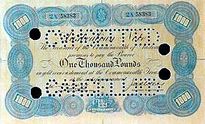Many, if not most collectors, start by collecting the banknotes of their own country. The first notes are usually those used every day and a set is easily put together. This can become more challenging if one tries to find notes from a previous series, but only occasionally still found in circulation. Reaching this point, the budding collector starts recruiting friends and relatives to help look for less common, still circulating specimens.
As soon as the first banknote is acquired for collecting and not for spending, the second challenge becomes upgrading the finds. Since the first notes are usually saved from circulation, each time the new collector gets a better one, he or she can spend the old note and keep the better one, until the example in the collection becomes the ultimate – a pristine, perfect, uncirculated specimen.
As I told my friend earlier, a source of good banknotes is travel. Being a traveling collector is not without its problems. You go to a country and at the airport or local bank, buy or exchange your country’s notes for the money of the visited country. Until you get a feel for the money of the new country, everything looks collectable. In my own case, I don’t want to spend any new notes until I have examined each note I receive from the bank or hotel for varieties, keeping an example of all the different ones - sometimes the whole lot! Unfortunately, my wife does not see the money in the same light, especially when I tell her I want to keep this or that, and we now need to buy more local currency before we can go out.
Her view is we can always get more later. Not so! The first time I changed money in France, only a few months after the Euro was introduced, I received several pristine 100 Euro notes. Listening to my wife, we spent them. To this day, I have never received another perfect note of the 100 euro denomination.
Getting back to themes, some place, some time, just about every subject you can think of has been illustrated on a banknote. Fascinating collections can be put together based on single subjects. One of the most popular is boats and ships. These can range from modern ocean vessels, such as a series a few years ago issued by Singapore, to dugout canoes depicted on the banknotes of several African countries. My favorite ship is on the back of a 100 escudos note from Chile (P-141) of a sailing ship (the Esmeralda) underway with all its sails deployed. There is even a dealer who specializes in banknotes with ships or boats in their designs. The ships appearing on some of the notes he lists are sometimes tiny and obscure, but they are there!
The number of themes is unlimited. Volcanoes are popular, appearing on the banknotes of Japan (Mt. Fujiyama on P-95, 500 yen), Segara Anak in Indonesia (P-137), Mt. Damavand in Iran (P-146), Kilimanjaro in Tanzania (P-32 and others) and several countries in Latin America.
Great collections can be made of birds. I don’t know of any dealers specializing in them, but local birds can be found on the banknotes of nearly every country. My favorites are the bird-of-paradise on the $100 note of Trinidad and Tobago,and the bird series (P-146 to 154) issued by Suriname in 2000. I know collectors with specialized collections of famous and infamous people, insects (butterflies are popular), airplanes, art, fish, invasion money, nudes, scenery, archaeology, trains, architecture, horses, even special denominations, such as $3 banknotes, or those sporting a denomination of one million.
Even special types of banknotes come into play. A prominent Australian dealer, has a personal collection of “siege notes” – issued by towns or generals to pay for goods within the areas surrounded by their enemies. Notes issued for use exclusively in concentration camps, on ships, in military circles, or by certain towns or groups of towns are all very collectable.
My interests are eclectic. I collect any type of banknote I don’t already have from anyplace in the world. My preference is for type notes; that is, differing design elements, but many collectors go for completeness – searching for every signature combination, differing issue date, watermarks, replacements, block letters and serial number fonts.
The one unifying theme for all collectors is collecting what we like. In my case, I may not collect what the guy next to me does, but you can be sure I will find his collection interesting. Its all about learning and appreciating those bits of printed money most of us take for granted!


